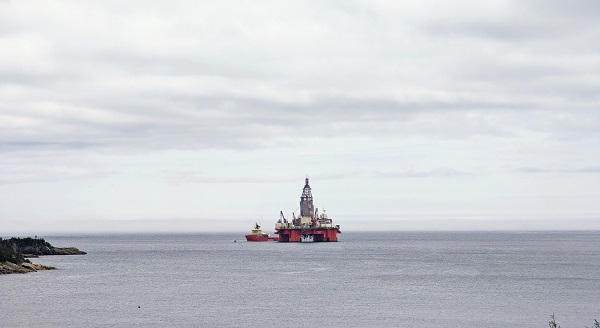Energy
There is no better time for the Atlantic to follow the Pacific as the next stage of Canadian energy development

Premier Tim Houston says it’s time for Nova Scotia to develop its energy industry
In late January, Nova Scotia Premier Tim Houston announced that natural resources would become a major focus of his government, stating that it was time to, “We can’t expect Nova Scotia to prosper when we ban industry after industry after industry.”
It was announced that his government would look into fracking for natural gas, uranium mining, and lifting fossil fuel extraction moratoriums along the coast.
Atlantic Canada is poised to become the next major player in Canada’s energy expansion. With growing global demand for clean energy, a shift toward resource independence, and the looming threat of U.S. tariffs, provinces like Newfoundland and Labrador and Nova Scotia are taking bold steps to develop their energy sectors. Recent developments in liquefied natural gas (LNG), offshore oil, green hydrogen, and critical minerals are positioning the region as a crucial pillar of Canada’s energy future.
Donald Trump’s threats to impose tariffs on Canadian energy exports have forced Canada to reassess its reliance on the United States as its primary customer. This shift has already played out in Quebec, where the government is reconsidering its stance on LNG projects. Similarly, Atlantic Canada recognizes the need to diversify its energy exports to Europe and Asia. With vast offshore oil reserves and new LNG projects in the works, the region is set to capitalize on international markets.
Premier Houston has emphasized the importance of local resource development to secure the province’s economy. Though he has walked back on previous comments about revisiting the Georges Bank offshore drilling moratorium, his government is clearly focused on increasing natural resource production. The seafood industry, a vital component of the region’s economy, has expressed concerns about potential energy developments affecting fisheries, but a balance must be struck to ensure both industries thrive.
Newfoundland and Labrador Premier Andrew Furey has made it clear that offshore oil will continue to play a key role in the province’s economy for decades. Addressing industry leaders, Furey positioned Newfoundland as the future “energy capital of North America,” highlighting new offshore projects and hydrogen development. ExxonMobil’s $1.5 billion investment in offshore infrastructure underscores industry confidence in the region’s potential.
Despite dubious global forecasts suggesting oil demand will peak in the coming years, Newfoundland and Labrador believes its high-quality, low-emission crude will remain in demand, particularly in Europe and Asia. Additionally, the province is exploring hydrogen production, backed by federal incentives and private investment. Companies like World Energy GH2 are pushing forward with large-scale green hydrogen projects, despite local opposition from residents concerned about the environmental impact of wind farms.
As British Columbia emerges as an LNG powerhouse, Atlantic Canada is following suit. The region’s proximity to European markets gives it a significant advantage, particularly in light of geopolitical instability affecting global energy supplies. With European nations scrambling to secure reliable energy sources, Atlantic Canada’s LNG potential is more valuable than ever.
Much like British Columbia, where First Nations have played a central role in LNG expansion, Atlantic Canada has an opportunity to develop Indigenous-led energy projects. Federal tax incentives and emissions regulations will shape how LNG projects move forward, ensuring they align with Canada’s climate commitments while driving economic growth.
The combination of Trump’s tariffs, shifting global energy markets, and renewed provincial interest in resource development has created a perfect storm for Atlantic Canada’s energy sector. With strong government backing, significant private investment, and growing international demand, the region is well-positioned to become a major energy player.
As Canada navigates this new era of energy expansion, Atlantic Canada’s strategic location, resource wealth, and commitment to innovation make it a natural frontier for growth. Whether through LNG, offshore oil, hydrogen, or critical minerals, the region’s energy sector is set to thrive in the coming decades.
Energy
Indigenous-led Projects Hold Key To Canada’s Energy Future

From the Frontier Centre for Public Policy
Indigenous leaders call for policy reforms and Indigenous equity ownership to unlock Canada’s energy potential
A surprising twist in Canada’s pipeline debate emerged on Jan. 21, 2025, when Alberta Premier Danielle Smith called for a revival of the Northern Gateway pipeline.
Unexpectedly, Grand Chief Stewart Phillip, president of the Union of B.C. Indian Chiefs, voiced support, warning that if Canada doesn’t act, Donald Trump will. Yet just a day later, Phillip abruptly retracted his statement, raising fresh questions about external influence and the future of Indigenous participation in energy development.
Northern Gateway, a pipeline once proposed to carry Alberta oilsands crude to the B.C. coast for export to Asia, was cancelled in 2016 after years of environmental opposition and legal challenges. Its demise became a symbol of Canada’s broader struggles to balance resource development, environmental concerns and Indigenous rights. Now, amid rising global energy demand and growing Indigenous interest in ownership stakes, calls to revive the project are resurfacing, with political, legal and economic implications.
Adding to the intrigue, Phillip has long been a vocal critic of major resource projects, including Northern Gateway, making his initial endorsement all the more surprising.
Some observers, like Calvin Helin, a member of the Tsimshian Nation and principal at INDsight Advisers, see deeper forces at work. A lawyer specializing in commercial and Indigenous law and a best-selling author, Helin believes the incident highlights how environmental activists are shaping the conversation.
“Environmental groups have infiltrated some Indigenous organizations,” Helin said in an interview. “They managed to support a government that championed their agendas, particularly Alberta-focused objectives like the coastal pipeline ban and changes to the regulatory approval system. In this era of Trump, all they’ve managed to do is weaken Canada’s position.”
Nonetheless, Helin emphasized that the energy industry has learned the importance of genuine engagement with Indigenous interests. He pointed out that Indigenous leaders increasingly support responsible natural resource development. Inclusion and recognition from the outset, Helin argued, are essential for energy projects in 2025 and beyond.
After the cancellation of Northern Gateway, Indigenous leader Dale Swampy, who helped establish the Northern Gateway Aboriginal Equity Partners, formed the National Coalition of Chiefs, a pro-development alliance of First Nation chiefs advocating for oil and gas development in their communities.
Swampy continues to champion the idea of a pipeline dedicated solely to moving bitumen to the coast, arguing that Canada has been “putting all its eggs in one basket” by selling almost exclusively to the United States while competitors, including the U.S. itself, have entered global markets.
According to the Canadian Energy Centre, global demand for oil and gas in emerging and developing economies is expected to remain robust through 2050. With the added pressures of U.S. tariffs, conversations about Canadian pipelines to tidewater have gained urgency. Swampy advocates for a policy reset and the revival of Northern Gateway, this time powered by Indigenous equity investment.
“First, we’ve got to get rid of the oil tanker ban (Bill C-48),” Swampy said. “We need more fluid regulatory processes so we can build projects on a reasonable timeline, without costing us billions more waiting for approvals—like TMX (Trans Mountain Expansion Project). And you’ve got to get the proponents back to the table. Last time, 31 of the 40 communities were already signed on. I believe we can get them on board again.”
Swampy continues to work with industry partners to develop an Indigenous-led bitumen pipeline to the West Coast. “We can get this project built if it’s led by First Nations.”
He also noted that other Indigenous leaders are increasingly recognizing the benefits of collaborating on resource development, whether in mining or B.C. LNG projects, which he says enjoy widespread First Nations support.
Discussions with Helin, Swampy and other Indigenous leaders resulted in the following policy recommendations for 2025 and beyond.
- Repeal Bill C-69, the Impact Assessment Act. It blocks not only pipelines but also mines, refineries, export plants and other energy infrastructure in which First Nations want to invest. The Supreme Court of Canada ruled it unconstitutional on Oct. 13, 2023.
- Cut taxes to offset U.S. tariffs. Reducing taxes on investment and energy projects can neutralize tariff impacts and attract new investment. Eliminate the carbon tax, which Indigenous leaders argue has placed Canada at a strategic disadvantage globally.
- Repeal Bill C-59, the so-called greenwashing bill. According to Stephen Buffalo, president and chief executive officer of the Indian Resource Council of Canada, this legislation has silenced many voices within the Indigenous energy community.
- Approve LNG plants and related infrastructure. Canada currently sells gas exports almost exclusively to the United States, but there’s a strong business case for expanding to Asian and European markets. In a recent Canadian Energy Ventures webcast, it was revealed that LNG sold to Europe fetches up to 16 times the price Canada receives from U.S. sales. First Nations are already successfully involved in Woodfibre LNG, Cedar LNG and Ksi Lisims LNG in B.C.
- Cut regulatory delays. Prolonged approval timelines erode investor confidence. Streamlining processes can help projects proceed in reasonable timeframes.
Finally, clarify reconciliation guidelines. Clearly define what constitutes meaningful consultation. Industry must treat Indigenous peoples as true partners, advancing economic reconciliation through equity partnerships.
A social media stir over Northern Gateway has reignited debate over Indigenous ownership in Canada’s energy future. While some leaders waver, others like Helin and Swampy make a compelling case: Indigenous-led projects are crucial for Canada’s economic and energy security. Their message is clear — repeal restrictive policies, accelerate project approvals and embrace Indigenous equity. If Ottawa removes the roadblocks, Canada can unlock its full energy potential.
Maureen McCall is an energy business analyst and Fellow at the Frontier Center for Public Policy. She writes on energy issues for EnergyNow and the BOE Report. She has 20 years of experience as a business analyst for national and international energy companies in Canada.
Energy
Many Canadians—and many Albertans—live in energy poverty

From the Fraser Institute
By Tegan Hill and Elmira Aliakbari
Amid an ongoing trade war with the United States, which will increase prices for Canadian and American consumers alike, affordable energy is crucial to fuel our daily lives and power the economy. Unfortunately, energy prices have been rising for years, straining household budgets across Canada including in Alberta.
For perspective, from 2002 to 2023 (the latest year of available data) the price of energy (electricity, gasoline, etc.) grew by 105.5 per cent compared to 53.5 per cent for non-energy goods and services. This reflects a significantly higher increase in energy prices compared to other goods.
Why have energy prices increased?
While there are many factors, bad government policy has added fuel to the fire. The list includes the federal carbon tax, which remains in place for large industrial emitters. And Ottawa’s “Clean Electricity Regulations,” which mandate that by 2050, 100 per cent of Canada’s electricity must come from clean energy sources as wind, solar, hydro, etc. To meet this goal, Canada would need to build a massive amount of new infrastructure and technology, potentially driving electricity costs even higher.
Of course, Canadians pay the price for bad policy. Due in part to rising energy prices, in 2021 (the latest year of available data), 11.0 per cent of Canadians lived in “energy poverty”—that is, at least 10 per cent of their household total annual spending paid for energy-related goods such as electricity, natural gas, gasoline and other heating fuels. In Alberta, the number was 10.0 per cent. All told, that’s a lot people in energy poverty.
And energy poverty disproportionally affects lower-income households. For instance, in 2021 across Canada, 22.1 per cent of households earning $31,200 or less, and 20.7 per cent earning between $31,200.01 and $55,000, were in a state of energy poverty compared to only 1.6 per cent of households earning more than $124,000.
When the next federal government—whoever that may be—works with the provinces to develop energy policy, it should understand the significant level of energy poverty in Canada including Alberta, particularly among low-income households. Increasing energy prices further would likely increase the burden on families already experiencing energy poverty and those families at risk of falling into it.
-

 Alberta2 days ago
Alberta2 days agoProvince to expand services provided by Alberta Sheriffs: New policing option for municipalities
-

 Bruce Dowbiggin1 day ago
Bruce Dowbiggin1 day agoIs HNIC Ready For The Winnipeg Jets To Be Canada’s Heroes?
-

 2025 Federal Election1 day ago
2025 Federal Election1 day agoCSIS Warned Beijing Would Brand Conservatives as Trumpian. Now Carney’s Campaign Is Doing It.
-

 2025 Federal Election1 day ago
2025 Federal Election1 day agoNo Matter The Winner – My Canada Is Gone
-

 Alberta1 day ago
Alberta1 day agoMade in Alberta! Province makes it easier to support local products with Buy Local program
-

 Health1 day ago
Health1 day agoHorrific and Deadly Effects of Antidepressants
-

 2025 Federal Election1 day ago
2025 Federal Election1 day agoCampaign 2025 : The Liberal Costed Platform – Taxpayer Funded Fiction
-

 2025 Federal Election1 day ago
2025 Federal Election1 day agoA Perfect Storm of Corruption, Foreign Interference, and National Security Failures




